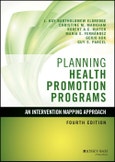Planning Health Promotion Programs is the "bible" of the field, guiding students and practitioners through the planning process from a highly practical perspective. Using an original framework called Intervention Mapping, this book presents a series of steps, tasks, and processes that help you develop effective health promotion and education programs using a variety of approaches. As no single model can accurately predict all health behavior or environmental changes, this book shows you how to choose useful theories and integrate constructs from multiple theories to describe health problems and develop appropriate promotion and education solutions. This new fourth edition has been streamlined for efficiency, with information on the latest theories and trends in public health, including competency-based training and inter-professional education. New examples and case studies show you these concepts in action, and the companion website provides lecture slides, additional case studies, and a test bank to bring this book directly into the classroom.
Health education and health promotion is a central function of many public health roles, and new models, theories, and planning approaches are always emerging. This book guides you through the planning process using the latest developments in the field, and a practical approach that serves across discipline boundaries. - Merge multiple theories into a single health education solution - Learn the methods and processes of intervention planning - Gain a practical understanding of multiple planning approaches - Get up to date on the latest theories, trends, and developments in the field
Both academic and practice settings need a realistic planning handbook based on system, not prescription. Planning Health Promotion Programs is the essential guide to the process, equipping you with the knowledge and skills to develop solutions without a one-size-fits-all approach.
Table of Contents
Figures and Tables vii
Acknowledgments xiii
About the Authors xvii
Part One: Foundations 1
Chapter 1 Overview of Intervention Mapping 3
Competency 3
Perspectives 7
Intervention Mapping Steps 12
Core Processes for Using Theory and Evidence 20
The Role of Culture in Intervention Planning 28
Navigating the Book 30
Important Repeating Concepts in the Book 31
Summary 32
Discussion Questions and Learning Activities 38
References 39
Chapter 2 Behavior-Oriented Theories Used in Health Promotion 57
Competency 57
Perspectives 58
Overview of Theories 65
Learning Theories 66
Theories of Information Processing 70
Theories of Health Behavior 74
Theories of Reasoned Action 78
Theories of Goal-Directed Behavior 84
Theories of Automatic Behavior, Impulsive Behavior, and Habits 89
Stage Theories 95
Attribution Theory and Relapse Prevention 99
Theories of Persuasive Communication 101
Theories of Self-Regulation 105
Social Cognitive Theory 109
Theories of Stigma and Discrimination 113
Diffusion of Innovations Theory 116
Summary 120
Discussion Questions and Learning Activities 120
References 121
Chapter 3 Environment-Oriented Theories 145
Competency 145
Perspectives 146
General Environmental-Oriented Theories 149
Interpersonal-Level Theories 155
Organizational-Level Theories 160
Community-Level Theories 167
Societal and Governmental Theories 184
Summary 192
Discussion Questions and Learning Activities 192
References 193
Part Two: InterventionMapping Steps 209
Chapter 4 Intervention Mapping Step 1: LogicModel of the Problem 211
Competency 211
Perspectives 212
Tasks for Step 1 214
Summary 261
Discussion Questions and Learning Activities 262
References 263
Chapter 5 Intervention Mapping Step 2: Program Outcomes and Objectives - LogicModel of Change 283
Competency 283
Perspectives 284
Tasks for Step 2 286
Summary 330
Discussion Questions and Learning Activities 331
References 332
Chapter 6 Intervention Mapping Step 3: Program Design 345
Competency 345
Deciding How to Start 345
Perspectives 350
Tasks for Step 3 355
Summary 416
Discussion Questions and Learning Activities 417
References 418
Chapter 7 Intervention Mapping Step 4: Program Production 435
Competency 435
Perspectives 436
Tasks for Step 4 437
Summary 475
Discussion Questions and Learning Activities 475
References 476
Chapter 8 Intervention Mapping Step 5: Program Implementation Plan 483
Competency 483
Perspectives 484
Tasks for Step 5 494
Summary 528
Discussion Questions and Learning Activities 529
References 530
Chapter 9 Intervention Mapping Step 6: Evaluation Plan with Patricia Dolan Mullen 541
Competency 541
Perspectives 541
Tasks for Step 6 546
Summary 584
Discussion Questions and Learning Activities 585
References 585
Chapter 10 Using Intervention Mapping to Adapt Evidence-Based Interventions with Linda Highfield, Marieke A. Hartman, Patricia Dolan
Mullen, and Joanne N. Leerlooijer 597
Competency 597
Perspectives 598
Intervention Mapping for Adaptation 603
Summary 642
Discussion Questions and Learning Activities 643
References 643
Index 651








